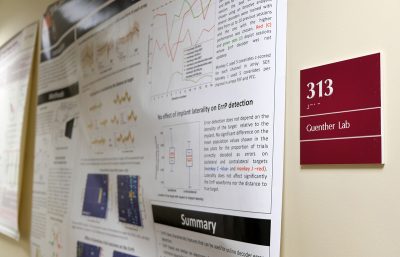The Guenther Lab, a neuroscience lab researching speech movement at Boston University, published a scientific paper late last semester connecting stutters with a malfunction in the brain’s initiation circuit.

The paper, called “A neurocomputational view of developmental stuttering,” was published in Nov. 2021 and discusses the lab’s prior research on stuttering, said Frank Guenther, moderator of the lab and a professor of speech, language and hearing sciences and biomedical engineering.
Guenther said the brain’s initiation circuit determines when to say a particular speech sound “like an on and off switch.” Once given an initiation signal, another circuit in the brain, the articulation circuit, generates muscles that move the vocal tract, resulting in speech.
Stuttering, he explained, originates from a problem with the basal ganglia in the initiation circuit, a structure that helps a human make sound and speech automatically.
“When you’re first learning to say a word, you have to think about it a lot more,” Guenther said. “But as you do that over and over, the basal ganglia kind of learns what order to do this sound in for that word … you just think of the word and the basal ganglia does the rest.”
Guenther said stuttering begins to arise in children around the age of three which is when children are learning words.
“The basal ganglia isn’t very good at determining, for some reason, exactly when to initiate sounds,” Guenther said. “Sometimes, the sounds become delayed, or sometimes it’ll start a sound and then not be able to do the next one, so it’ll repeat the first sound.”
Researchers from the lab developed a computer model to simulate stuttering by separating the initiation circuit from the articulation circuit, Guenther said. The model helped to explain scenarios such as why stuttering occurs at the beginning of a sentence.
“When they say … words at the beginning of the sentence … they’re much more likely to stutter than if they say them later in the phrase,” Guenther said. “So what that tells us is, they can actually produce the word … the articulation circuit works fine … it’s just when that word’s at the beginning of the sentence, for some reason, they have trouble initiating it.”
He added that research for the paper was carried out over several years, and was primarily worked on by a team of six to seven researchers. The research took a combination of two things — working on the computer model and experiments.
One type of experiment, called behavioral experiments, involved a subject sitting in front of a computer and they are given words to say, Guenther said. Researchers then manipulated what the subject heard and tracked how the subject responded to the change.
Guenther said they also ran MRI experiments, in which they brought in both people who stuttered and people who didn’t stutter and monitored their differences in brain activity as they spoke. Researchers then compared the results to those predicted by the computer model.
“We’ve refined it over the years, so it generally does a good job,” said Guenther. “What we are particularly interested in is, can the model explain differences in brain activity for people who stutter compared to those who don’t?”
Alexander Acosta, a senior in the College of Arts and Sciences, said he has been working mostly on behavioral research at the lab.
“[Working at the Guenther lab] has shown me many wider applications that I didn’t expect from studies of neurolinguistics,” Acosta, who began his research at the Guenther Lab last summer, said. “I didn’t realize that the base levels of how we use language and how language is represented in the brain is actually just in the control of our muscles.”
Lauren Jiang, a senior in Sargent College studying speech, language and hearing sciences, said while she was at the lab, she was working on four projects revolving around how the brain stores and processes sound and makes it into speech.
“It did lay a very good foundation for going into my future career as a speech language pathologist because a lot of what we do with patients has to be evidence based, and the research is where you get your evidence from,” Jiang said.
The Guenther Lab is still continuing to conduct research and develop technology surrounding speech disorders and the neural components of speech.


























































































































